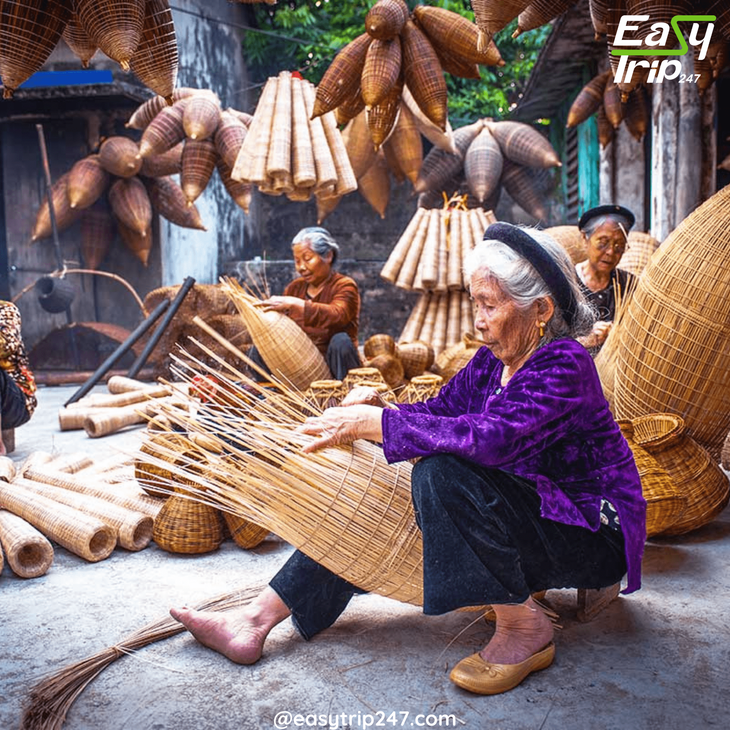Hanoi's Craft Villages: A Walking Tour Of Traditional Vietnamese Artisans
On
17/05/2025Reading time:
0 min
Summary:
Embarking on a walking tour in Hanoi is an extraordinary way to delve into the heart of Vietnam’s rich artistic heritage, particularly through its enchanting craft villages.

Just a short distance from the bustling capital, these villages are home to skilled artisans who have preserved traditional techniques passed down through generations. A walking tour in Hanoi that includes visits to these craft villages offers a unique opportunity to witness the intricate artistry and dedication that define Vietnamese craftsmanship. From pottery and silk weaving to lacquerware and bamboo products, each village presents its own distinct flavor and cultural significance, making this journey not just a tour but a profound exploration of Vietnamese identity.
Your walking tour in Hanoi can begin in the famous Bat Trang Pottery Village, located about 13 kilometers from the city center. Known for its exquisite ceramics, Bat Trang has been producing pottery for over 700 years. As you stroll through the village, you’ll be greeted by the sight of artisans skillfully shaping clay on potter’s wheels, their hands deftly crafting beautiful vases, dishes, and decorative items. Many workshops welcome visitors to try their hand at pottery, providing a hands-on experience that connects you directly with the craft. Engaging with the local artisans during your walking tour in Hanoi not only allows you to appreciate their skills but also gives you insight into the cultural significance of pottery in Vietnamese life. Don’t forget to explore the charming shops selling a variety of pottery items, perfect for souvenirs or gifts that reflect the artistry of this unique village.
Continuing your walking tour in Hanoi, make your way to the serene village of Van Phuc, renowned for its silk weaving. This village, with its lush greenery and peaceful atmosphere, is a haven for those interested in the intricate process of silk production. As you wander through the narrow streets lined with silk shops, you’ll see artisans working diligently at their looms, creating stunning fabrics that showcase vibrant colors and intricate patterns. The craftsmanship involved in silk weaving is truly remarkable, and many shops offer guided tours that explain the entire process, from silkworm cultivation to the final product. As you engage with the artisans, you’ll learn about the history of silk in Vietnam and its importance in traditional clothing, especially during festivals and weddings. A visit to Van Phuc during your walking tour in Hanoi is not just about shopping; it’s about experiencing a living tradition that continues to thrive in modern times.
Next on your walking tour in Hanoi should be the village of Dong Ho, famous for its traditional woodblock printing. This village has been creating vibrant folk paintings for centuries, often depicting scenes of rural life, mythology, and celebrations. As you walk through Dong Ho, you’ll be captivated by the colorful prints displayed in local workshops. Many artisans are happy to share their techniques with visitors, allowing you to observe the meticulous process of carving designs into woodblocks and applying natural dyes to create stunning prints. Participating in a workshop can be a highlight of your walking tour in Hanoi, providing a memorable experience that connects you with the artistic heritage of the region. Whether you choose to purchase a piece of art or simply enjoy the beauty of the craft, Dong Ho offers a delightful glimpse into the world of traditional Vietnamese art.
As your walking tour in Hanoi continues, don’t miss the opportunity to visit the village of lacquerware artisans in Hanoi’s outskirts. Lacquerware is a highly regarded craft in Vietnam, known for its glossy finish and intricate designs. The process of creating lacquerware is labor-intensive, involving multiple layers of natural lacquer derived from the sap of the lacquer tree. As you explore the workshops, you’ll witness artisans applying layers of lacquer to wooden items, meticulously sanding and polishing them to achieve a stunning finish. Many artisans incorporate mother-of-pearl inlays, creating breathtaking pieces that reflect the beauty of Vietnamese culture. Engaging with these artisans during your walking tour in Hanoi not only allows you to appreciate their craftsmanship but also deepens your understanding of the cultural significance of lacquerware in Vietnamese traditions.
Another fascinating stop on your walking tour in Hanoi is the village of Phu Vinh, known for its bamboo products. This village is a treasure trove of creativity, where artisans transform bamboo into a wide range of items, from furniture and home decor to intricate handicrafts. As you walk through the village, you’ll see artisans skillfully weaving bamboo into beautiful shapes, showcasing their creativity and resourcefulness. Many workshops offer demonstrations and workshops, inviting visitors to learn about the various techniques used in bamboo crafting. Participating in a bamboo weaving session can be a fun and engaging way to connect with the local culture, and you’ll leave with a deeper appreciation for this sustainable craft. A walking tour in Hanoi that includes Phu Vinh provides a unique perspective on how traditional crafts can adapt to modern needs while preserving cultural heritage.
As your journey through Hanoi’s craft villages unfolds, take the time to savor the local cuisine that reflects the region’s culinary traditions. Many villages have small eateries or street vendors offering delicious local dishes, providing a perfect opportunity to refuel during your walking tour in Hanoi. Try some traditional Vietnamese dishes, such as pho or banh cuon, which are often made using locally sourced ingredients. Enjoying a meal in the heart of the craft villages allows you to experience the warm hospitality of the locals while indulging in the flavors of Vietnam.
Throughout your walking tour in Hanoi, you’ll also encounter the welcoming smiles of the artisans and their families, who are eager to share their stories and traditions. Their passion for their crafts is evident, and engaging in conversations with them can provide valuable insights into the challenges and joys of preserving traditional skills in a rapidly changing world. By supporting these artisans and purchasing their handmade products, you are not only taking home a piece of Vietnamese culture but also contributing to the sustainability of their craft and livelihoods.
In conclusion, a walking tour in Hanoi that explores its craft villages is a captivating journey through the heart of Vietnamese artistry and culture. From the pottery of Bat Trang to the silk weaving of Van Phuc, each village offers a unique glimpse into the skills and traditions that define Vietnam’s rich heritage. Engaging with local artisans, participating in workshops, and savoring traditional cuisine adds depth to your experience, making your walking tour in Hanoi not just a sightseeing excursion but a meaningful exploration of the country’s cultural identity. So, lace up your walking shoes and set out on this unforgettable journey through Hanoi’s craft villages, where every step reveals the beauty of traditional Vietnamese craftsmanship and the stories of the artisans who keep these age-old traditions alive.
Design Your Tour Today And Get A Quote. Contact Us Here: +84.975.504.825
Source: Easytrip247 Team compiled.
